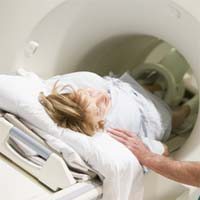Mesothelioma Prognosis Accuracy Improves with PET/CT ‘Delayed Phase’

More research has confirmed the value of FDG-PET/CT technology for predicting treatment response in mesothelioma – especially when the scan is conducted in two phases.
Positron emission tomography (PET) is a nuclear medicine imaging technique that produces three-dimensional images of functional processes in the body. When the molecule FDG (fluorodeoxyglucose, a type of sugar) is used as the tracer, PET allows doctors to ‘see’ metabolic processes as they are happening. Because metabolism is often higher in cancer cells, FDG-PET has proven to be a useful tool for diagnosing mesothelioma, the asbestos-linked cancer. When FDG-PET is combined with computed tomography (CT), another powerful imaging test, the resulting images contain even more potentially crucial diagnostic, staging and prognostic information for mesothelioma.
Now, a study conducted in Japan and published in the international medical journalOncology Reports has found that FDG-PET/CT may be even more effective for determining mesothelioma prognosis when used in a particular way. The researchers reviewed the FDG-PET/CT results of 31 patients who had been confirmed as having mesothelioma. While 30 (97%) of the patients showed abnormal cellular uptake of the FDG when they were scanned 1 hour after being injected with the FDG tracer, one did not. The results of scans done at 60 minutes are referred to as ‘early phase’ results.
But when the same scan was administered 2 hours after the injection (called ‘delayed phase’), all 31 mesothelioma patients were found to have abnormal scans. Furthermore, the abnormal FDG uptake values at the delayed phase were higher in every patient than they were at the early phase. The delayed phase scan also found metastasis to the lymph nodes in 7 (23%) patients and to other areas in 8 (26%) mesothelioma patients. The researchers concluded that an abnormal FDG uptake value in the delayed phase “is a more reliable prognostic factor than in the early phase”.
In another recent wide-ranging assessment of the FDG-PET/CT technique in Molecular Imaging and Biology, a group of Indian researchers conceded that “disease prognosis… is an evolving area where this modality has demonstrated significant promise” and that dual time point and delayed imaging may improve the technology’s effectiveness for this purpose. If the results of the Japanese study are confirmed in further studies, it suggests that mesothelioma doctors who use FDG-PET/CT scans should rely more heavily on the uptake values seen in the delayed phase of the test, rather than the early phase, in determining the patient’s prognosis.
Sources:
Abe, Y et al, “Clinical implications of 18F-fluorodeoxyglucose positron emission tomography/computed tomography at delayed phase for diagnosis and prognosis of malignant pleural mesothelioma”, October 24, 2011, Oncology Reports, Epub ahead of print.
Basu, S, “Current Evidence Base of FDG-PET/CT Imaging in the Clinical Management of Malignant Pleural Mesothelioma: Emerging Significance of Image Segmentation and Global Disease Assessment”, October 2011, Molecular Imaging and Biology, pp. 801-11.





